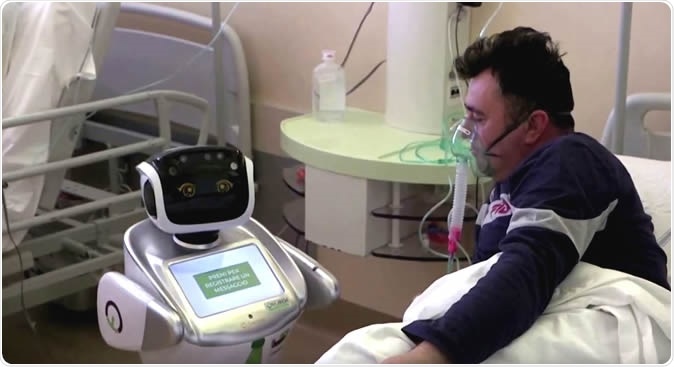Robots can significantly help in the fight against the coronavirus disease (COVID-19) that is spreading across the globe. As the number of cases tops one million, and the death toll reaching 53,000, scientists race to develop a drug or vaccine for the infectious disease. Now, robots are playing a major role in this fight, improving the health and safety of individuals and patients.

Six robot nurses at Circolo hospital in Varese, Italy, are reading information from equipment that measures patients' vital statistics and relaying it to doctors and nurses. The area has been hit the hardest by coronavirus and medical staff say the robots enable them to monitor patients more closely. Credit: Reuters
A team of international scientists from the Institute of Medical Robotics, Shanghai Jiao Tong University, Robotics and Intelligent Systems, ETH Zurich, Switzerland, Texas A&M University, Stanford University, and the, The BioRobotics Institute in Scuola Superiore Sant'Anna, highlights the role of robots in the current global pandemic, offering cost-effective solutions to contribute to the control of the spread.
There are many ways robots can help combat the coronavirus disease. They can work as disinfectant-spraying robots and drones to monitor people during a lockdown. Many scientists worldwide are currently working to reduce the impact of the pandemic, and at the same time, shed light on the role of automation in supplementing human skills. Robots can also provide aid to health workers by doing some of the jobs.
In the study, published in the journal Science, the team explored the potential of robot technologies to fight the pandemic.
Role of robotics in the COVID-19 fight
Robots play many roles and can be useful resources during the COVID-19 public health emergency. Robots have the potential to be deployed for disinfection to deliver essential goods such as medicine and food, assisting in border control, and monitoring vital signs of people.
In Italy, for instance, they are using a robot nurse called Tommy. Tommy is one of six robots providing aid to doctors and nurses, caring for COVID-19 patients at the Circolo Hospital in Varese City, in Lombardy, the epicenter of the outbreak in Italy.
Robots keep medical staff safer in Italian hospital by monitoring patients
The robot plays the role of a nurse who stays at the patient's bedside so doctors can look after others who are in serious condition. The robot monitors the patient in the room and relays information to the hospital staff. The patient can use the robot's touchscreen to allow them to record messages and talk to doctors. The robot helps to significantly limit the number of direct contact doctors, and nurses have with a patient, hence, reducing their risk of infection.
Areas were robots are needed
In the 2015 Ebola outbreak, the White House Office of Science and Technology organized workshops that identified three broad areas where robotics are beneficial – clinical care, logistics, and surveillance. Clinical care encompasses decontamination and telemedicine, logistics involve the handling and delivery of contaminated waste, and reconnaissance entails the monitoring compliance of voluntary quarantines and those who are in locked-down regions.
China has used many of these applications, and other countries can do it, too. For instance, in a city in the Philippines, disinfectant drones are being used to help contain the virus. Further, frontline practitioners are exposed to the pathogen through direct patient contact, emphasizing the need for protective gear. Robots like Tommy protect the health workers from contracting the virus.
The current COVID-19 outbreak has introduced another area of robotic use – continuity of work and maintenance of socioeconomic functions.
Disease prevention is vital in containing the virus, and this can be done through disinfection. Robot-controlled noncontact ultraviolet (UV) surface disinfection is now being used since the virus can spread through contaminated surfaces. The virus can stay on surfaces for days, especially plastic and metals. Hospitals can use robots to disinfect the area and reduce the infection of health workers.
Robots can also play a pivotal role in the screening and diagnosis of patients. Robots can act as vital signs monitoring devices in public areas. They can help monitor the temperature in places where people enter and in ports of entry. Camera systems can help screen multiple people at the same time in large areas.
Robots can help in other areas like in collecting and testing throat swabs for diagnosis and drawing of blood for collecting samples through venipuncture. They can also aid in delivering medicines and essential goods. Other areas where robots can be beneficial include telemedicine, teleoperation, online seminars, handling of dangerous waste products, and doing other high-risk tasks for humans, among others.